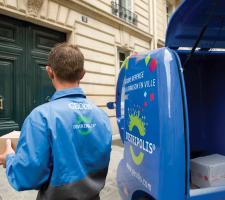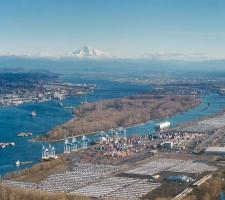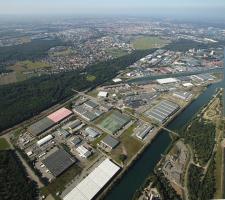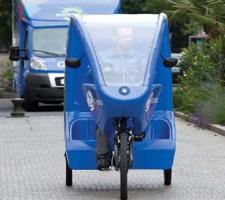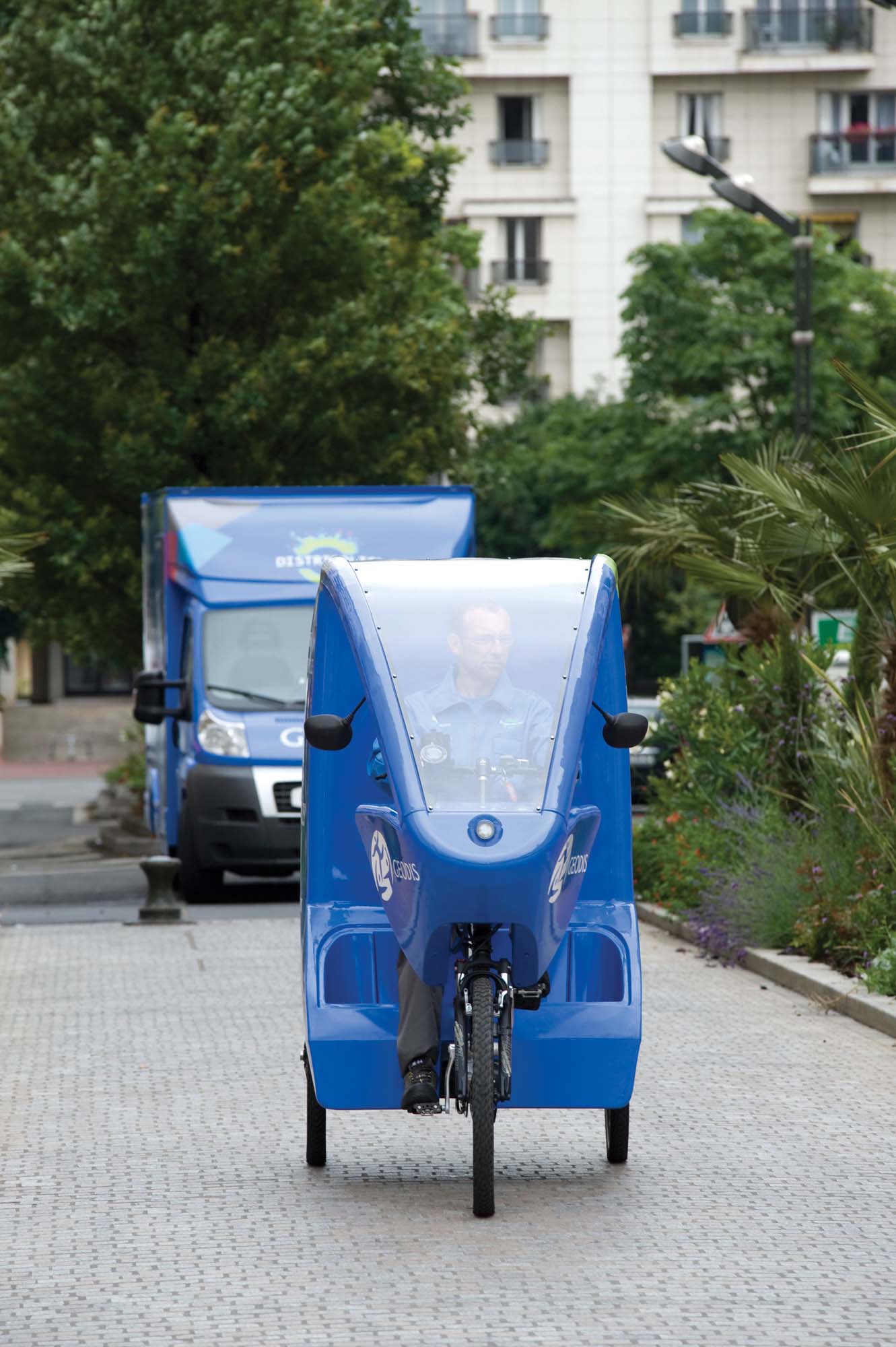
Distripolis vehicles on the road
David Crawford welcomes a national First.
Urban freight movements, while commercially and socially vital, are a growing logistical headache for planners and people alike. Figures from France’s Lyon Laboratory of Transport Economics indicate that goods transport in major urban areas accounts for: 20% of traffic; 35% of CO2 emissions made by all urban trips; and 50% of the diesel used; while final km delivery runs account for 20% of the total cost of the transport chain.
Solutions being adopted include the designation of low emission zones, imposing access and delivery time restrictions, and rigorously enforcing parking regulations to the point of adding huge annual penalty bills to operating costs. Indeed in the UK the6983 Freight Transport Association has warned that, without official action, whole areas of London could prove uneconomical for some of its members to deliver to by 2015.
A softer, more industry-friendly approach which is attracting renewed interest is the freight consolidation centre (FCC). This is designed to enable the progressive scaling down of traffic movements and so minimise the risk of clashes over access.
Typically built on the outskirts of a city and near good motorway connections, this aims to improve the management of freight access and movement onwards from the national network. Heavy trucks can use the FCC to unload goods that are destined for multiple central area addresses, such as retailers, which are then reassembled for forward delivery using less polluting (and less congesting) vehicles.
These operations generally run on the operating company’s specially-developed, logistics-oriented navigation and tracking tools. There are currently over 115 FCCs in operation, mostly in Europe where the majority are in just five countries - France, Germany, Italy, the Netherlands and the UK.
The advantage for trucking companies is they can avoid having their large vehicle snarled up for hours in urban traffic. Instead, they can more profitably use the bigger vehicles on longer, smoother runs with lower fuel consumption.
In France, supply chain logistics specialist Geodis, a subsidiary of national freight operator SNCF, has now opened three of its planned rollout of a number of Distripolis FCCs across the country. This is the First-ever national-scale implementation of the concept, made possible by Geodis’s links with a major transport infrastructure owner.
The first scheme got under way in its initial phase in Paris in 2011, followed by Strasbourg in early 2012 and Versailles, 17km west of Paris, later in 2012. This latest opening represents the scheme’s first launch at sub-city level – Versailles has a population of only 90,000, but a service and tourism-based economy catering for six million visitors a year.
The initiative sets out to handle French urban goods movement in a seamless sequence from off-motorway arrival at a major depot to completion of the final km run to the city-centre businesses awaiting their consignment. It uses vehicles ranging from heavy, diesel-fuelled trucks to lighter, greener ones; and then powered tricycles and warehouse-style electric pallet trucks.
The initiative reflects the fact that, in the Greater Paris region, heavy goods vehicles produce 26% of total transport CO2 emissions. At busy times of day, freight transport is responsible for 50% of particulate emissions and one-third of the NOx and SO2 pollutants created by all road vehicles.
Again, half the city’s buildings experience noise levels of more than 68dB - above the recommended 65dB threshold for urban conditions.
The programme has four main elements:
The linked Copilote terminal navigates vehicles by the most effective route and logs both delivery acknowledgement and location data for capture by Geodriver to be used in schedule tracking and management information. According to the company the routing system cuts the distances travelled by its vehicles by between 5% and 10%.
The Paris rollout aims to deliver a projected total of eight BLUEs by 2015. The predictions for then are - CO2 savings of 1,742 tonnes per year; NOx savings of 2.6 tonnes per year; and CO savings of 1.9 tonnes per year. At the same time, the company expects to reduce the number of its vehicles on the road by 20%, with additional noise level reductions.
A depot in the port area feeds two BLUEs located in the heart of the conurbation, one in the north, one in the south. The company’s current fleet of 36 diesel-engined vehicles will be progressively replaced by electric ones, except for heavy consignments.
Its agreement with the Strasbourg city government envisages a reduction of at least 40% in its greenhouse gas emissions. It sees the latest depot in Versailles as a pilot for schemes to serve smaller towns with populations of between 40,000 and 100,000 - typically those needing to balance the conservation of historic centres against the economic benefits of tourism. The company is planning schemes on varying scales in up to 30 French cities and towns and is also eyeing prospects in other European countries.
7761 Bestufs) series of projects, set up to address the issue of the impact of heavy goods transport on the urban quality of life and codify best practice. Its recommendations reflect the aftermath of a premature, 1990s boom in urban FCC developments, mainly in Central Europe.
Many of these failed and were subsequently abandoned, for reasons including ineffective management by, or lack of support from, public authorities. The resulting legacy of disillusionment discouraged investment in further initiatives for some years.
Among factors underpinning the current second wave is the availability of ITS solutions for vehicle and consignment tracking and tracing, route planning, vehicle navigation and reporting.
BESTUFS’ recommendations include the added value of the incorporation, wherever possible, of reverse logistics (ie vehicles returning with waste for recycling) and careful consideration of the roles of public authorities, many of which ‘have only limited understanding of freight transport systems’. They strongly urge caution based on experiences with publicly-funded and/or-operated FCCs that ‘have mostly been negative from the commercial perspective’.
It therefore recommends that FCCs are best operated by the private sector, with the public sector focussing on support activities such as ensuring good land-use and planning frameworks, implementing access regulations that favour highly-occupied, low-emission vehicles, and intelligent traffic management.
BESTUFS’ thinking is evidently proving influential well beyond the borders of Europe – certainly as far as North America, where the FCC concept is less well-known. In its 2012 Sustainable Freight Strategy report, for example, the US city of Portland, Oregon, draws heavily on the project as its major reference source.
Portland is a regional freight hub for most modes - air, rail, marine and barge, as well as truck (which account for 67% of freight movements). It is anticipating sustained population growth over the next 20 years, with an accompanying increase in the demand for products—and the freight traffic to deliver them – resulting in rising competition for street space.
The report concludes that ‘We lack the funding or the space simply to increase roadway capacity – and, even if we could, experience around the world has shown that to be inefficient to solve traffic problems.’ Taking on board BESTUFS’ views on the public sector, it has decided not to take a lead role itself but to focus on using planning tools to reinforce its existing Central Eastside industrial district as a virtual FCC.
Urban freight movements, while commercially and socially vital, are a growing logistical headache for planners and people alike. Figures from France’s Lyon Laboratory of Transport Economics indicate that goods transport in major urban areas accounts for: 20% of traffic; 35% of CO2 emissions made by all urban trips; and 50% of the diesel used; while final km delivery runs account for 20% of the total cost of the transport chain.
Solutions being adopted include the designation of low emission zones, imposing access and delivery time restrictions, and rigorously enforcing parking regulations to the point of adding huge annual penalty bills to operating costs. Indeed in the UK the
A softer, more industry-friendly approach which is attracting renewed interest is the freight consolidation centre (FCC). This is designed to enable the progressive scaling down of traffic movements and so minimise the risk of clashes over access.
Typically built on the outskirts of a city and near good motorway connections, this aims to improve the management of freight access and movement onwards from the national network. Heavy trucks can use the FCC to unload goods that are destined for multiple central area addresses, such as retailers, which are then reassembled for forward delivery using less polluting (and less congesting) vehicles.
These operations generally run on the operating company’s specially-developed, logistics-oriented navigation and tracking tools. There are currently over 115 FCCs in operation, mostly in Europe where the majority are in just five countries - France, Germany, Italy, the Netherlands and the UK.
The advantage for trucking companies is they can avoid having their large vehicle snarled up for hours in urban traffic. Instead, they can more profitably use the bigger vehicles on longer, smoother runs with lower fuel consumption.
In France, supply chain logistics specialist Geodis, a subsidiary of national freight operator SNCF, has now opened three of its planned rollout of a number of Distripolis FCCs across the country. This is the First-ever national-scale implementation of the concept, made possible by Geodis’s links with a major transport infrastructure owner.
The first scheme got under way in its initial phase in Paris in 2011, followed by Strasbourg in early 2012 and Versailles, 17km west of Paris, later in 2012. This latest opening represents the scheme’s first launch at sub-city level – Versailles has a population of only 90,000, but a service and tourism-based economy catering for six million visitors a year.
The initiative sets out to handle French urban goods movement in a seamless sequence from off-motorway arrival at a major depot to completion of the final km run to the city-centre businesses awaiting their consignment. It uses vehicles ranging from heavy, diesel-fuelled trucks to lighter, greener ones; and then powered tricycles and warehouse-style electric pallet trucks.
The initiative reflects the fact that, in the Greater Paris region, heavy goods vehicles produce 26% of total transport CO2 emissions. At busy times of day, freight transport is responsible for 50% of particulate emissions and one-third of the NOx and SO2 pollutants created by all road vehicles.
Again, half the city’s buildings experience noise levels of more than 68dB - above the recommended 65dB threshold for urban conditions.
The programme has four main elements:
- One or more major centres for receiving grouped shipments to the city as a whole. In Paris, the centre is located at Bercy to the south-east of the city centre, which has a history of warehousing dating back to the 18th century.
- Deliveries of consignments weighing more than 200kg direct from the centre by Euro 5 emissions standard-compliant trucks (in the longer term, Euro 6 or hybrid trucks).
- A network of bases logistiques urbaines écologiques (environmental urban logistic bases BLUEs) located close to cities’ main retail districts (eight in the case of Paris). These are fed during the day by the current fleet of Euro5 standard-compliant trucks.
- Finally, deliveries from the BLUE bases for parcels and pallets weighing less than 200kg by light ‘green’ vehicles, tricycles and pallet trucks.
The linked Copilote terminal navigates vehicles by the most effective route and logs both delivery acknowledgement and location data for capture by Geodriver to be used in schedule tracking and management information. According to the company the routing system cuts the distances travelled by its vehicles by between 5% and 10%.
The Paris rollout aims to deliver a projected total of eight BLUEs by 2015. The predictions for then are - CO2 savings of 1,742 tonnes per year; NOx savings of 2.6 tonnes per year; and CO savings of 1.9 tonnes per year. At the same time, the company expects to reduce the number of its vehicles on the road by 20%, with additional noise level reductions.
Regional rollout
Strasbourg, on the River Rhine and at the border with Germany, is a multimodal crossroads for freight transport and the second-largest inland port in France. It hosts over 320 companies spread over 1,000ha of land and several satellite sites along a 100km stretch of river bank.A depot in the port area feeds two BLUEs located in the heart of the conurbation, one in the north, one in the south. The company’s current fleet of 36 diesel-engined vehicles will be progressively replaced by electric ones, except for heavy consignments.
Its agreement with the Strasbourg city government envisages a reduction of at least 40% in its greenhouse gas emissions. It sees the latest depot in Versailles as a pilot for schemes to serve smaller towns with populations of between 40,000 and 100,000 - typically those needing to balance the conservation of historic centres against the economic benefits of tourism. The company is planning schemes on varying scales in up to 30 French cities and towns and is also eyeing prospects in other European countries.
Best practice
The concept is one outcome of the European Commission - supported BEST Urban Freight Solutions (Many of these failed and were subsequently abandoned, for reasons including ineffective management by, or lack of support from, public authorities. The resulting legacy of disillusionment discouraged investment in further initiatives for some years.
Among factors underpinning the current second wave is the availability of ITS solutions for vehicle and consignment tracking and tracing, route planning, vehicle navigation and reporting.
BESTUFS’ recommendations include the added value of the incorporation, wherever possible, of reverse logistics (ie vehicles returning with waste for recycling) and careful consideration of the roles of public authorities, many of which ‘have only limited understanding of freight transport systems’. They strongly urge caution based on experiences with publicly-funded and/or-operated FCCs that ‘have mostly been negative from the commercial perspective’.
It therefore recommends that FCCs are best operated by the private sector, with the public sector focussing on support activities such as ensuring good land-use and planning frameworks, implementing access regulations that favour highly-occupied, low-emission vehicles, and intelligent traffic management.
BESTUFS’ thinking is evidently proving influential well beyond the borders of Europe – certainly as far as North America, where the FCC concept is less well-known. In its 2012 Sustainable Freight Strategy report, for example, the US city of Portland, Oregon, draws heavily on the project as its major reference source.
Portland is a regional freight hub for most modes - air, rail, marine and barge, as well as truck (which account for 67% of freight movements). It is anticipating sustained population growth over the next 20 years, with an accompanying increase in the demand for products—and the freight traffic to deliver them – resulting in rising competition for street space.
The report concludes that ‘We lack the funding or the space simply to increase roadway capacity – and, even if we could, experience around the world has shown that to be inefficient to solve traffic problems.’ Taking on board BESTUFS’ views on the public sector, it has decided not to take a lead role itself but to focus on using planning tools to reinforce its existing Central Eastside industrial district as a virtual FCC.


